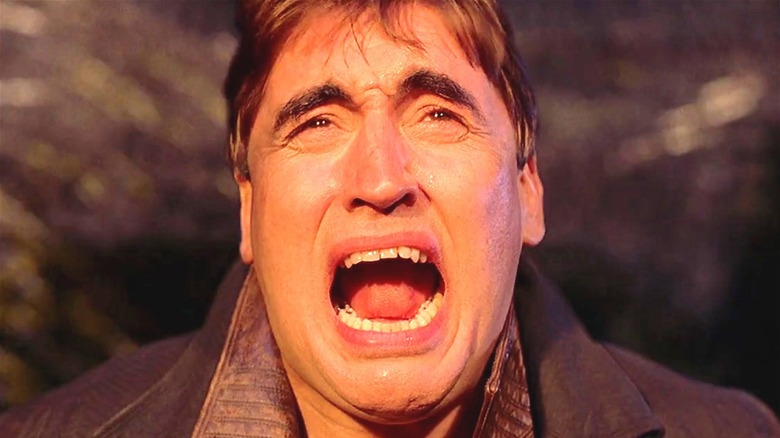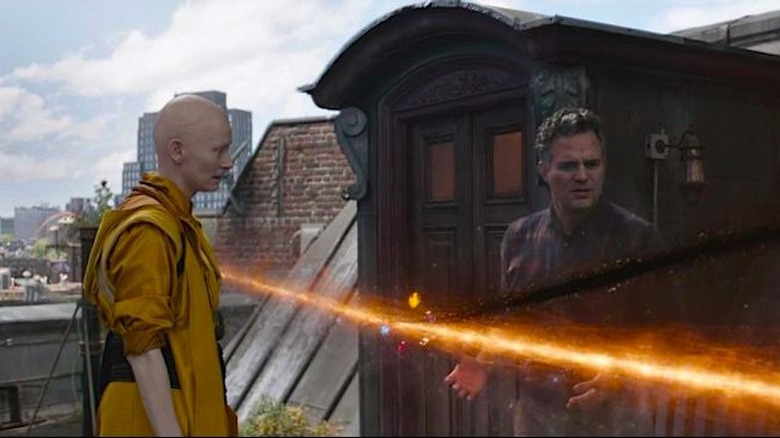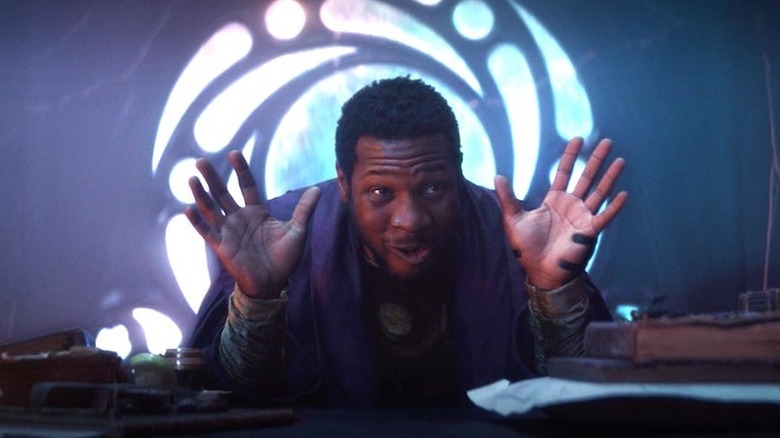Does Sending Back The No Way Home Villains Create New Timelines?
2021 was a pretty big year for the Marvel Cinematic Universe, not only because of multiple hit movies, but also the small screen fleshing out of other heroes and villains that launched on Disney+. "WandaVision" and "Loki" have been especially important in the MCU's grand tapestry, looking forward, because they play with the idea of the multiverse.
"WandaVision" set the stage for inter-dimensional madness by confirming that the Scarlet Witch (Elizabeth Olsen) is a Nexus Being (someone who can alter the Universal Time Stream and change reality how they see fit), while "Loki" looked at the multiverse through the Time Variance Authority, who keep alternate timelines in check — as well as variants of people who exist in the main universe. This was all a way of preparing audiences for "Spider-Man: No Way Home." From here on out, we'll be talking about Spider-spoilers, so here's your final warning: Stop reading if you haven't seen "No Way Home."
Tom Holland's third solo "Spider-Man" film (if it can really be called that) sees the title character grapple with his secret identity, which was outed to the world at the end of "Spider-Man: Far From Home." This leads him to Doctor Strange (Benedict Cumberbatch) who casts a unique spell to make everyone forget that Peter Parker is Spider-Man. Unfortunately, this bungled sorcery also brings in a horde of multiverse villains who know Peter's true identity, and it's up to the ol' web-head to send them back.
In the end, by teaming up with two alternate universe Spider-Men (Tobey Maguire and Andrew Garfield), the Peters successfully cure Doctor Octopus (Alfred Molina), Green Goblin (Willem Dafoe), Sandman (Thomas Hayden Church), Electro (Jamie Foxx) and Lizard (Rhys Ifans) before sending them home.
But does this create new timelines in those two universes?
The Ancient One says it should
Cast your mind back to the time heist sequence in "Avengers: Endgame" where Earth's Mightiest Heroes try to pluck the stones out of time to create their own Infinity Gauntlet. Professor Hulk visits the Sanctum Sanctorum to persuade the Ancient One (Tilda Swinton) to give up the Time Stone, however, she explains the flaws in the plan: "The Infinity Stones create what you experience as the flow of time. Remove one stone and the flow splits. Now, this may benefit your reality — but my new one, not so much."
Obviously, the villains in "No Way Home" don't make up the flow of time, but in changing their fate and putting them back into their own universe, it would drastically change the outcome of each movie. For example, Norman Osborn would be free of his Green Goblin persona, meaning he wouldn't try to murder Peter (Tobey Maguire) or kidnap Mary Jane Watson (Kirsten Dunst). Ultimately, he'd survive the events of the film. Who knows how that would change the Raimi-verse? Meanwhile, a cured Otto Octavius could quite easily be a scientific force for good after the events of "Spider-Man 2," or even an ally to Spider-Man himself, rather than dying at the bottom of the Hudson River. The same goes for the Lizard, as Dr. Curt Connors was a brilliant scientist at Oscorp before his reptile accident, and a cured Electro might mean Gwen Stacy survives the ending of "The Amazing Spider-Man 2." The possibilities are endless.
To get over these complications, it seems likely that all these villains must return to new, branched timelines. This means that the original Raimi and Webb universes still proceed as we saw in the previous movies, but there are now variant timelines (separate from the movies we saw) that the cured villains return to, instead of technically going back to their original homes. This would be the most logical extension of Marvel's rules, as laid out thus far.
But that only brings us to another question...
Did Kang and the Time Variance Authority allow No Way Home to happen?
In "Loki" episode 1, the titular God of Mischief is told by the Time Variance Authority that the Avengers' time travel was sanctioned by the Time Keepers — who are later revealed as He Who Remains (Jonathan Majors), aka Nathaniel Richards. But since the TVA's whole purpose in "Loki" is to stop timelines branching off from one another, it means that Richards must've sanctioned the villains going back to their own universes, if they did indeed create a new branch of reality. Otherwise, a handful of TVA agents would've come crashing through those orange time doors to apprehend the villains sometime during "No Way Home," because by the MCU's own logic, they are variants — much like Loki himself.
Keep in mind, when He Who Remains actually introduces himself, he clarifies that the TVA's true mission is solely focused on preventing alternate (I.E., even more dangerous) variants of himself. That means He Who Remains (and by extension, the TVA) is fine with the variant Spider-villains, because they don't cause the sorts of timeline disruptions that would eventually create another version of Richards (say, Kang the Conqueror).
Alternatively, there's a common theory that the "No Way Home" finale happens at the same time as the "Loki" ending — with the multiverse opening up thanks to the death of He Who Remains. If that is the case, then the TVA was simply too overwhelmed to fix the new timelines created by the villains returning home alive.
The next film in the MCU's slate is "Doctor Strange in the Multiverse of Madness." So, it'll be interesting to see how the sequel deals with all this, well ... multiverse madness.


